Pancake
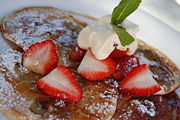
A pancake is a thin, flat cake prepared from a batter and cooked on a hot griddle or frying pan. Pancakes exist in several variations in many different local cuisines. Most pancakes are quick breads, though some are made using a yeast-raised or fermented batter. Pancakes can be eaten at different times of the day depending on local tradition.
Most varieties of pancakes, but not the Breton galette, are cooked one side at a time on a griddle and flipped halfway through the cooking process to cook the other side. The process of tossing or flipping is part of the essence of the pancake, and one of the skills that separates the experienced cook from the beginner. It is traditional to turn pancakes over by tossing them in the air using the pan and without using any other implements. This is a tricky maneuver that requires practice to perfect.
In Canada and the United States, the pancake is usually a breakfast food, but it is so popular that a franchised restaurant formerly called International House of Pancakes, now referred to as IHOP, has more than 1000 restaurants serving at all hours of the day. A "pancake supper" can be a social event (in the manner of an ice cream social or barbecue), with pancakes served at dinnertime. Pancake suppers are sometimes held as fund raisers.
In Australia and Britain, pancakes are eaten as a dessert, or served savory with a main meal. They can sometimes be eaten as a main meal (the savory variety, also known as crepes), as they are in the U.S. and Canada. In Australia, Pancakes are so popular that franchised restaurants called Pancake Parlour and Pancakes on the Rocks are present.
A smaller pancake, often called a "silver dollar" pancake, is sometimes used in the creation of hors d'oeuvres in place of crackers or other bread-like items.
Contents |
Regional Varieties
Europe
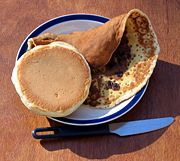
English pancakes have three key ingredients: plain flour, eggs, and milk. The batter is quite runny and forms a thin layer on the bottom of the frying pan when the pan is tilted. It may form some bubbles during cooking, which results in a pale pancake with dark spots where the bubbles were, but the pancake does not rise. These pancakes may be eaten as a sweet dessert with the traditional topping of lemon juice and sugar, drizzled with golden syrup, or wrapped around savory stuffings and eaten as a main course. Made from a similar recipe but baked instead of fried is Yorkshire pudding this batter rises because the air beaten into the batter expands, without the need for baking powder, the result is eaten as part of the traditional roast beef dinner . English pancakes are similar to French crêpes, and Italian crespelle, but are not "lacy" in appearance. English pancakes can be stuffed after cooking with a wide variety of sweet or savory fillings. Both versions can be sweetened after cooking by pouring on syrup or sprinkling with sugar.
Scottish and Irish pancakes, locally known as drop scones, pancakes or griddle cakes, are more like the American type and are served as such (see below). Scottish pancakes are made from self-raising flour, eggs, sugar and milk with Irish pancakes being made with soda-flour and buttermilk.
Smaller pancakes (usually about 3.5 in / 9 cm in diameter) are known in the UK as Scotch pancakes or drop-scones (after the traditional method of dropping batter onto a griddle (a girdle in Scots)), and in northern England, Australia and New Zealand as pikelets. They can be served with jam and cream or just with butter. In Scotland pancakes are served at teatime but mostly as breakfast. They are made plain and as fruit pancakes with raisins. Made to a similar recipe are crumpets. These are cooked on the griddle on one side until browned, then lightly cooked on the other side. Both Scotch pancakes and crumpets can be made with plain flour and baking soda as an alternative to self-raising flour.[1]
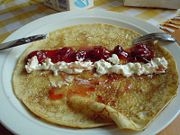
French crêpes, popular in France, Canada, and Brazil (where they may be called pancakes or crêpes) are made from flour, milk, and eggs. They are thin and are usually served with a large amount of sweet or savory filling, ranging from fruit and/or ice cream, to seafood (in Brazil, most usually ground meat).
German pancakes, are called Pfannkuchen (Pfanne translates to english pan, Kuchen simply means cake). German pancakes are the same as English pancakes. In some regions (Berlin, Brandenburg, Saxonia) pancakes are called Eierkuchen. In Swabia sliced pancake strips (Flädle) are often served in soup. A Berliner Pfannkuchen is not a pancake, it is a doughnut.

In Austria pancakes are called Palatschinke (a word derived from Latin placenta meaning cake), plural Palatschinken. Pancakes in Austria are usually thin, filled with apricot, plum, lingonberry, strawberry or apple jam, chocolate sauce or hazelnut spread. Kaiserschmarrn is an Austrian pancake including raisins, almonds, apple jam or small pieces of apple, split into pieces and usually sprinkled with powdered sugar.

In Hungary, pancakes called palacsinta (also derived from Latin placenta) are made from flour, milk and/or soda water, sugar, and eggs. Sweet wine can also be added to the batter. The filling is usually jam but sweet quark cheese, meat and mushroom fillings are also popular. Gundel palacsinta is a famous Hungarian pancake, stuffed with walnuts, zest, raisins and rum, served in chocolate sauce. The dish is often flambéed. The Hungarian pancakes are served as a main dish or a dessert.
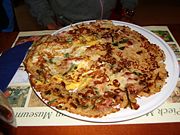
In the Netherlands and Flanders, pancakes are called Pannenkoeken and eaten at dinnertime. Pancake restaurants are popular family restaurants and serve many varieties of sweet, savory, and stuffed pancakes. Pannenkoek are slightly thicker than crepes and usually quite large (12" or more) in diameter. The batter is egg-based and the fillings can include sliced apples, cheese, ham, bacon, candied ginger and many other ingredients - alone or in combination - as well as "stroop", a thick syrup. One classical Dutch filling is a combination of bacon and stroop.
In Poland pancakes called Naleśniki are similar to those in Austria. They can be served as a main dish. They can be served sweet usually with fresh fruits (e.g Bilberry), Powidła, fruit jam. Also with variety of savory fillings e.g. fried chicken or even tuna with different additions like cheese potatoes or ham. In Poland Naleśniki are also used for making croquettes.
In Russia, Poland and Ukraine, blintz and blini are made from wheat or buckwheat flour, yeast, butter, eggs and milk. Blini cooking has an ancient history in Russia dating back to the pagan traditions and feasts.
In Sweden and Finland, it is traditional to eat yellow pea soup followed by pancakes on Thursdays.
Scandinavian pancakes are similar to the French crêpes. They are often served with jam and whipped cream or ice cream as a main dish with a variety of savory fillings. Traditional Swedish variations can be somewhat exotic. Beside the usual thin pancakes which resembles the French crêpes and are eaten on Thursdays together with pea soup, the Swedish cuisine has plättar which resembles tiny English pancakes, and are fried several at a time in a special pan. Others resemble German pancakes but include fried pork in the batter; these are baked in the oven. Potato pancakes called raggmunk contain shredded raw potato, and may contain other vegetables (sometimes the pancake batter is omitted, producing rårakor). Raggmunk and rårakor are traditionally eaten with pork rinds and lingonberry jam. A special Swedish pancake is saffron pancake from Gotland, made with saffron and rice, baked in the oven. Norwegians like their pancakes with sugar or blueberry jam, and they are often served with hot soup. Norwegians eat a great deal of rice pudding/porridge - leftovers from this can be made into small pancakes called "lapper".
North America
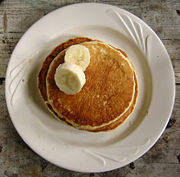
American or Canadian pancakes (also known as hotcakes, griddlecakes, or flapjacks in the U.S.) are Scotch pancakes which contain a raising agent, usually baking powder, and contains different proportions of eggs, flour, and milk or buttermilk, which create a thick batter. Cinnamon and sugar can be added. This batter is either ladled or poured onto a hot surface, and spreads to form a circle about ¼ or ⅓ inch (1 cm) thick. The raising agent causes bubbles to rise to the uncooked side of the pancake, at which point the pancake is ready to be flipped. These pancakes, very light in texture, are often served at breakfast topped with maple syrup, butter, peanut butter, jelly, jam, fruit or even honey.
North American can be made sweet or savory by adding ingredients such as blueberries, strawberries, cheese, bacon, bananas, apples or chocolate chips to the batter. In addition, some recipes call for the addition of spices such as nutmeg or cinnamon, or flavoring agents such as vanilla extract. A "silver dollar" pancake refers to a pancake about 3 inches (7 cm) in diameter - these are usually served in portions of five or ten.
Flapjacks in the U.S. are sometimes larger, thinner and more crisp than a regular American pancake, sometimes as broad as 12 inches in diameter.
Vermont pancakes usually have oatmeal or buckwheat flour added to the wheat flour, and require more baking powder to rise. The texture is coarser and the flavor more intense. The pancakes are served with maple syrup which is a famous product of Vermont.
"German Pancakes" or Dutch baby pancakes served in American pancake houses are shaped like a bowl and come in a range of sizes. They are commonly eaten with lemons and powdered sugar, jam, or caramelized apples.
Mexican hotcakes, are similar in style to pancakes served in the U.S., hotcakes are more often made with cornmeal as well as or instead of wheat flour. Hotcakes are popular breakfast items at restaurants throughout the country, and are often sold by street vendors in cities and during the local celebrations of small towns through the day and evening; the vendors usually sell a single hotcake topped with different sauces such as condensed milk, fruit jam or a sweet goat milk spread called "cajeta."
Alberta sub-variety In Alberta the term Nack or Nack's has been coined to describe a misshapen or hastily made Pancake. This term is thought to have come from the northern oilsands labor camps.
Australasia
In Australia and New Zealand, ingredients for pancakes usually consist of egg, milk, flour etc. (similar to the English style, rather than the American version), and are typically eaten as a dessert, although, like in America, can be often served for breakfast. Popular toppings include maple syrup, butter, peanut butter, jelly, jam, or assorted fruits such as strawberries. In both countries pancakes can also be served within a savoury meal.
Africa
Pancakes in South Africa are similar to English pancakes. They are traditionally prepared by the Afrikaans community on gas-stoves, and called pannekoek in Afrikaans, often eaten on wet and cold days. Pannekoek are most commonly served with cinnamon-flavored sugar (and sometimes lemon juice); the sugar may be left to dissolve onto the pancake; if eaten immediately the pancake has a crispy texture. This is a staple at Dutch Reformed Church fetes.[2] American-style "silver dollar" pancakes are also eaten in South Africa, where they are known as "plaatkoekies" or "flapjacks".
Asia
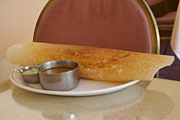
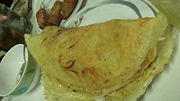
In Malaysia and Singapore, a pancake-like snack known as Apom Balik (in Malay) or Ban Chian Kuih (面煎粿 in Chinese). The Chinese version is made with a filling, traditionally ground peanut with sugar, butter and additional condiments like sweetened coconut or egg. Increasingly non traditional condiments like cheese, kaya (egg & coconut milk custard), blueberry or chocolate are used in response to demand for more interesting twist. There are other interesting variations, such as those made with soya bean milk replacing egg and water. The Malay version (Apom Balik) frequently has sweet corn and condensed milk as filling.
In the Philippines, pancakes or "hotcakes" are also served with syrup (maple or imitation corn syrup) margarine and sugar or condensed milk. They are usually served for breakfast, but there are roving street stalls that sell smaller hotcakes topped with margarine and sugar as an afternoon snack.
In Vietnamese cuisine, there is a wide variety of traditional pancakes; these include bánh xèo and bánh khọt in southern Vietnam, and bánh căn and bánh khoái in central Vietnam.
In India, a dish called the Pooda (sometimes called Cheela) is a variety of Pancake. They can be made either sweet or salty and are of different thickness as per region. They are made in a frying pan and are of a similar batter as their European counterparts. Dosa could be said to be another Indian pancake. It is prepared by fermenting rice batter. However the most correct definition would be what Punjabis call a Meetha Pooda which are a common breakfast food item in the Punjab. It is a sweet pancake which can also be eaten with pickles.
In Korea, pancakes include jeon, pajeon, bindaetteok, kimchijeon, and hotteok.
Banana pancakes, in particular, are a popular menu item in Western-oriented backpackers' cafes in many Asian countries such as Thailand, Vietnam, India, and China. This has elicited the term Banana Pancake Trail.
Pancake Day
In Canada,[3] the United Kingdom,[4] Ireland,[5] and Australia,[6] pancakes are traditionally eaten on Shrove Tuesday, which is also known as "Pancake Day" and, particularly in Ireland, as "Pancake Tuesday". (Shrove Tuesday is better known in the United States, France and other countries as Mardi Gras or Fat Tuesday.) Historically, pancakes were made on Shrove Tuesday so that the last of the fatty and rich foods could be used up before Lent.
Charity or school events are often organized on Pancake Day. One popular event is a "pancake race" in which each participant carries a pancake in a frying pan. All runners must toss their pancakes as they run and catch them in the frying pan. This event is said to have originated in the town of Olney, England in 1444 when a housewife was still busy frying pancakes to eat before the Lenten fast when she heard the bells of St Peter and St Paul's Church calling her to the Shriving Service. Eager to get to church, she ran out of her house still holding the frying pan complete with pancake, and still wearing her apron and headscarf. Pancake Day is widely celebrated in Australia; ready-made pancake mixes often sell out.
Every Shrove Tuesday since 1950 the towns of Olney, England and Liberal, Kansas, USA have competed in the International Pancake Race. Only local women may compete; they race along a previously agreed course and their times are compared to determine the international winner. In Olney the main women's race is now supported by races for local school children and men.
The Rehab UK Parliamentary Pancake Race also takes place every Shrove Tuesday, with teams from the House of Commons, the House of Lords and the Fourth Estate battling it out for the title of Parliamentary Pancake Race Champions. The fun relay race is all about raising awareness of the work of national brain injury charity, Rehab UK, and the needs of people with acquired brain injury.
See also
- Blintz
- Crêpe
- Dorayaki
- Dutch baby pancake
- Galette
- Injera
- Johnnycake
- Kaiserschmarrn
Footnotes
- ↑ Travel Scotland - Recipes – Scotch Pancakes, Tour Scotland, Ayrshire Pancakes
- ↑ Landbou.com
- ↑ "The Presbyterian Church in Canada". The Presbyterian Church in Canada. Retrieved on 4 January 2007.
- ↑ "Pancake Day (Shrove Tuesday), in the UK". British Embassy, Washington D.C.. Retrieved on 17 November 2006.
- ↑ "Shrove Tuesday - Pancake Day!". Irish Culture and Customs. Retrieved on 17 November 2006.
- ↑ "Easter in Australia". The Australian Government Culture and Recreation Portal. Retrieved on 17 November 2006.